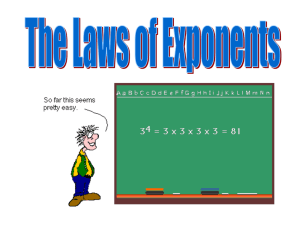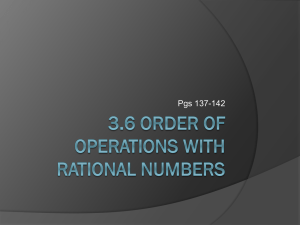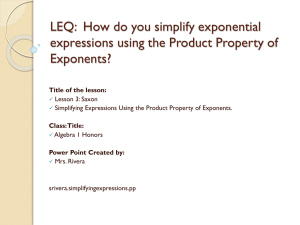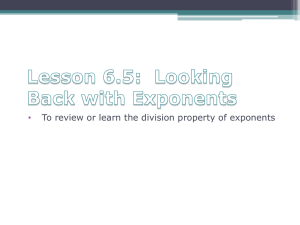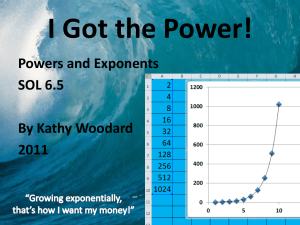Alg 1 - Ch 8.1 Multiplication Prop of Exponents
advertisement
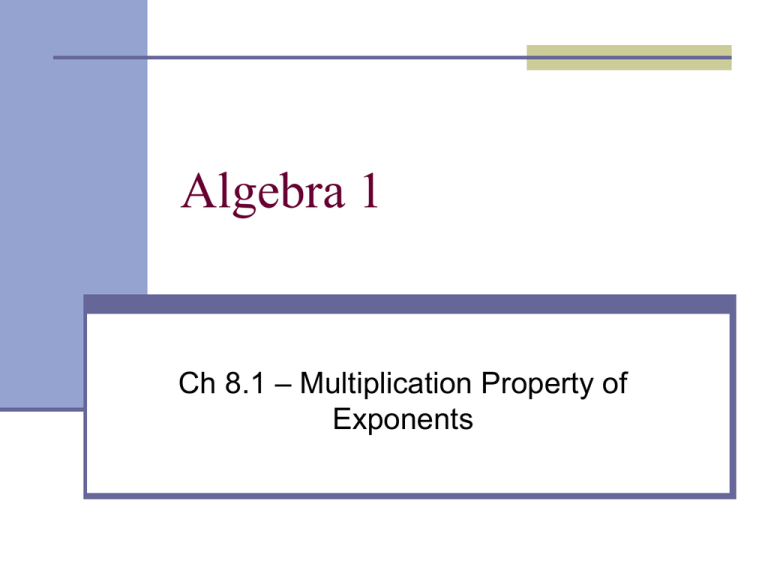
Algebra 1 Ch 8.1 – Multiplication Property of Exponents Objective Students will use the properties of exponents to multiply exponential expressions Before we begin In chapter 8 we will be looking at exponents and exponential functions… That is, we will be looking at how to add, subtract, multiply and divide exponents… Once we have done that…we will apply what we have learned to simplifying expressions and solving equations… Before we do that…let’s do a quick review of what exponents are and how they work… Review 4 5 Power or Exponent Base The above number is an exponential expression. The components of an exponential expression contain a base and a power The power (exponent) tells the base how many times to multiply itself In this example the exponent (4) tells the base (5) to multiply itself 4 times and looks like this: 5●5●5●5 Review – Common Error 5 4 A common error that student’s make is they multiply the base times the exponent. THAT IS INCORRECT! Let’s make a comparison: Correct: INCORRECT 5 ● 5 ● 5 ● 5 = 625 5 ● 4 = 20 One more thing… When working with exponents, the exponent only applies to the number or variable directly to the left of the exponent. Example: 3x4y In this example the exponent (4) only applies to the x If you have an expression in brackets. The exponent applies to each term within the brackets Example: (3x)2 In this example the exponent (2) applies to the 3 and the x Properties In this lesson we will focus on the multiplication properties of exponents… There are a total of 3 properties that you will be expected to know how to work with. They are: Product of Powers Property Power of a Power Property Power of a Product Property This gets confusing for students because all the names sound the same… Let’s look at each one individually… Product of Powers Property To multiply powers having the same base, add the exponents. Example: am ● an = am+n Proof: Three factors a2 ● a3 = a ● a ● a ● a ● a = a2 + 3 = a5 Two factors Example #1 53 ● 56 When analyzing this expression, I notice that the base (5) is the same. That means I will use the Product of Powers Property, which states when multiplying, if the base is the same add the exponents. Solution: 53 ● 56 = 53+6 = 59 Example #2 x2 ● x3 ● x 4 When analyzing this expression, I notice that the base (x) is the same. That means I will use the Product of Powers Property, which states when multiplying, if the base is the same add the exponents. Solution: x2 ● x3 ● x4 = x2+3+4 = x9 Power of a Power Property To find a power of a power, multiply the exponents Example: (am)n = am●n Proof: Three factors (a2)3 = a2●3 = a2 ● a2 ● a2 = a ● a ● a ● a ● a ● a = a6 Six factors Example #3 (35)2 When I analyze this expression, I see that I am multiplying exponents Therefore, I will use the Power of a Power Property to simplify the expression, which states to find the power of a power, multiply the exponents. Solution: (35)2 = 35●2 = 310 Example #4 [(a + 1)2]5 When I analyze this expression, I see that I am multiplying exponents Therefore, I will use the Power of a Power Property to simplify the expression, which states to find the power of a power, multiply the exponents. Solution: [(a + 1)2]5 = (a + 1)2●5 = (a + 1)10 Power of a Product Property To find a power of a product, find the power of each factor and multiply Example: (a ● b)m = am ● bm This property is similar to the distributive property that you are expected to know. In this property essentially you are distributing the exponent to each term within the parenthesis Example #5 (6 ● 5)2 When I analyze this expression, I see that I need to find the power of a product Therefore, I will use the Power of a Product Property , which states to find the power of a product, find the power of each factor and multiply Solution: (6 ● 5)2 = 62 ● 52 = 36 ● 25 = 900 Example #6 (4yz)3 When I analyze this expression, I see that I need to find the power of a product Therefore, I will use the Power of a Product Property , which states to find the power of a product, find the power of each factor and multiply Solution: (4yz)3 = 43y3z3 = 64y3z3 Example # 7 (-2w)2 When I analyze this expression, I see that I need to find the power of a product Therefore, I will use the Power of a Product Property , which states to find the power of a product, find the power of each factor and multiply Solution: (-2w)2 = (-2 ● w)2 = (-2)2 ● w2 = 4w2 Caution: It is expected that you know -22 = (-2)●(-2) = +4 Example #8 – (2w)2 When I analyze this expression, I see that I need to find the power of a product Therefore, I will use the Power of a Product Property , which states to find the power of a product, find the power of each factor and multiply Solution: – (2w)2 = – (2 ● w)2 = – (22 ● w2) = – 4w2 Caution: In this example the negative sign is outside the brackets. It does not mean that the 2 inside the parenthesis is negative! Using all 3 properties Ok…now that we have looked at each property individually… let’s apply what we have learned and look at simplifying an expression that contains all 3 properties Again, the key here is to analyze the expression first… Example #9 Simplify (4x2y)3 ● x5 I see that I have a power of a product in this expression (4x2y)3 Let’s simplify that first by applying the exponent 3 to each term within the parenthesis (4x2y)3 ● x5 = 43 ●(x2)3 ● y3 ● x5 I now see that I have a power of a power in this expression Let’s simplify that next by multiplying the exponents = 43 ●(x2)3 ● y3 ● x5 = 43 ● x6 ● y3 ● x5 (x2)3 Example #9 (Continued) = 4 3 ● x6 ● y3 ● x5 I now see that I have x6 and x5, so I will use the product of powers property which states if the base is the same add the exponents. Which looks like this: = 43 ● x11 ● y3 All that’s left to do is simplify the term 43 = 64 ● x11 ● y3 = 64x11y3 Comments These concepts are relatively simple… As you can see, to be successful here the key is to analyze the expression first…and then lay out your work in an organized step by step fashion…as I have illustrated. As a reminder, for the remainder of this course all the problems will be multi-step… Therefore, you will be expected to know these properties and apply them in different situations later on in the course when we work with polynomials and factoring… Comments On the next couple of slides are some practice problems…The answers are on the last slide… Do the practice and then check your answers…If you do not get the same answer you must question what you did…go back and problem solve to find the error… If you cannot find the error bring your work to me and I will help… Your Turn Simplify the expressions 1. c ● c ● c 2. x4 ● x5 3. (43)3 4. (y4)5 5. (2m2)3 Your Turn Simplify the expressions 6. (x3y5)4 7. [(2x + 3)3]2 8. (3b)3 ● b 9. (abc2)3(a2b)2 10. –(r2st3)2(s4t)3 Your Turn Solutions 1. c3 6. x12y20 2. x9 7. (2x + 3)6 3. 49 or 262,144 8. 33B4 or 27b4 4. y20 9. a7b5c6 5. 8m6 10. -r4s14t9 Summary A key tool in making learning effective is being able to summarize what you learned in a lesson in your own words… In this lesson we talked about multiplication properties of exponents. Therefore, in your own words summarize this lesson…be sure to include key concepts that the lesson covered as well as any points that are still not clear to you… I will give you credit for doing this lesson…please see the next slide… Credit I will add 25 points as an assignment grade for you working on this lesson… To receive the full 25 points you must do the following: Have your name, date and period as well a lesson number as a heading. Do each of the your turn problems showing all work Have a 1 paragraph summary of the lesson in your own words Please be advised – I will not give any credit for work submitted: Without a complete heading Without showing work for the your turn problems Without a summary in your own words…


